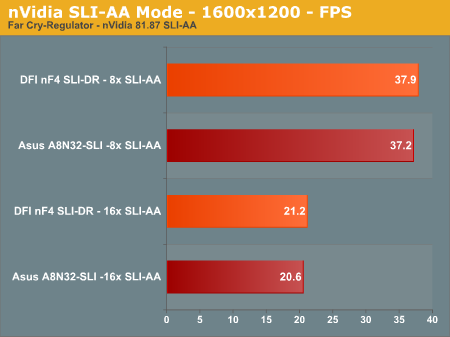Asus A8N32-SLI Deluxe: NVIDIA Dual x16 for the Athlon 64
by Wesley Fink on November 6, 2005 9:00 AM EST- Posted in
- Motherboards
NVIDIA SLI-AA
NVIDIA introduced special SLI-AA Modes beginning with driver version 77.7x. By running Coolbits, selecting "Advanced Settings" under "View" in the "Performance & Quality Settings" area, and selecting "SLI-Antialiasing" under the "SLI Rendering Mode", you have new options to run games at 16xAA or 8xAA independent of application control. There are many potential advantages to SLI-AA mode. You can find more information on how this feature works and the potential benefits at NVIDIA Announces 16x AA For SLI.
Since some have reported dramatic increases of up to double the speed using SLI-AA with the Dual x16 board, we ran benchmarks in SLI-AA modes using the same Far Cry game using our Regulator benchmark. As in our other testing the CPU, memory and drivers were the same for both boards. We even moved the hard drive between the two test setups to make sure everything except the motherboard was exactly the same. Since we had some problems with stability of the release 81.85 drivers in SLI-AA mode, we used the more recent 81.87 drivers which are also available in the Beta section at nVidia's wesite.
As you clearly see from the test results we did not find ANY performance improvement in either SLI-AA mode on the Dual x16 board compared to the Dual x8. In fact, the DFI Dual x8 was slightly faster than the Asus Dual x16 in theses tests. The results, however, were well within error tolerance and are equivalent - no difference. Perhaps more memory or lower resolutions would yield different results, but in the past we have consisitently found higher resolutions to benefit most from SLI and antialiasing.
NVIDIA introduced special SLI-AA Modes beginning with driver version 77.7x. By running Coolbits, selecting "Advanced Settings" under "View" in the "Performance & Quality Settings" area, and selecting "SLI-Antialiasing" under the "SLI Rendering Mode", you have new options to run games at 16xAA or 8xAA independent of application control. There are many potential advantages to SLI-AA mode. You can find more information on how this feature works and the potential benefits at NVIDIA Announces 16x AA For SLI.
Since some have reported dramatic increases of up to double the speed using SLI-AA with the Dual x16 board, we ran benchmarks in SLI-AA modes using the same Far Cry game using our Regulator benchmark. As in our other testing the CPU, memory and drivers were the same for both boards. We even moved the hard drive between the two test setups to make sure everything except the motherboard was exactly the same. Since we had some problems with stability of the release 81.85 drivers in SLI-AA mode, we used the more recent 81.87 drivers which are also available in the Beta section at nVidia's wesite.

As you clearly see from the test results we did not find ANY performance improvement in either SLI-AA mode on the Dual x16 board compared to the Dual x8. In fact, the DFI Dual x8 was slightly faster than the Asus Dual x16 in theses tests. The results, however, were well within error tolerance and are equivalent - no difference. Perhaps more memory or lower resolutions would yield different results, but in the past we have consisitently found higher resolutions to benefit most from SLI and antialiasing.










95 Comments
View All Comments
Zebo - Friday, November 4, 2005 - link
LOLLive - Friday, November 4, 2005 - link
The Techreport writes about overclocking with AMD Cool'n'Quiet here:They highlight two important bios options:
and with regards to memory overclocking:
Does this board have these options in bios?
As Techreport writes:
I must say I agree.
Link: http://techreport.com/etc/2005q4/damagebox/index.x...">http://techreport.com/etc/2005q4/damagebox/index.x...
DieLate - Saturday, November 5, 2005 - link
Can we get some official info on these questions?They're high on my list of features. I was all set to go with the DFI until I saw this review. These features may win me over if the ASUS has them too.
Live - Monday, November 7, 2005 - link
It looks like official reply is not going to happen. does anyone know if the Asus A8N SLI;Delux;Premium has this in later bios? If so I would bet this one has it aswell.Capt Caveman - Monday, November 7, 2005 - link
The latest bios for the Asus A8N-Sli Premium came out yesterday and no, it does not have this feature so I doubt the A8N32-Sli Deluxe will have this feature. Not very many overclocker's use CNQ, so I don't think there's a huge demand for this feature unfortunately.WobbleWobble - Friday, November 4, 2005 - link
I wonder if it's better than the DFI because of the PEG mode Asus implements on its motherboards, which overclocks the videocard.Wesley Fink - Friday, November 4, 2005 - link
And I disabled "PEG link" mode for our review. Asus has settings in PEG for Auto, Normal, Fast, Faster, and Disabled. We set "Disabled" because we know this trick. Asus suggests using "Faster" for review tests. On the positive side you have that additional performance waiting to be tapped.We also turn off the overclocks that are enabled when many boards arrive for review. That's the first thing we check.
psychobriggsy - Friday, November 4, 2005 - link
Really nice to see such diligence!Capt Caveman - Friday, November 4, 2005 - link
Not by 17%lopri - Friday, November 4, 2005 - link
Also, if you're running SLI with 2 dual-slot video cards, where are you supposed to put a sound card, or any PCI card? It seems like the only slot available will be, if it's possible at all, the one above the 2nd video card. Not sure how anyone's gonna be able to use any PCI card with SLI.